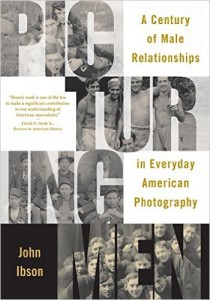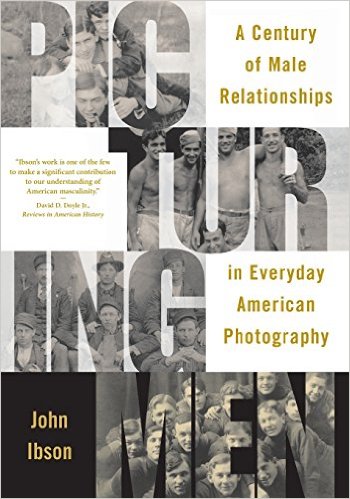 Picturing Men: A Century of Male Relationships
Picturing Men: A Century of Male Relationships
in Everyday American Photography
by John Ibson
Smithsonian Institution Press
237 pages, $32.95
SOMETIMES a hobby brings unexpected rewards, as in the case of John Ibson, an American studies professor at California State University, Fullerton. Testing the patience of his steadfast partner, Ibson scoured antique marts, yard and estate sales, bookstores, and the Internet in search of a particular slice of American history: photographs of men together from the 1860’s to the 1950’s. His collection now surpasses 5,000 images, and a well-organized selection of them has been compiled into Picturing Men, a startling book that contemplates the shifting conditions of American manhood.
In the ample text he writes to accompany these photos, Ibson avoids excessive speculation about the goings-on of these nameless men from the past, but he does use contemporary art and literature to re-imagine their private thoughts and feelings. He cites relevant films and litera ry works, everything from the poems of Walt Whitman to the silent film Wings, from the Hope-Crosby road movies to the books A Separate Peace and Advise and Consent. These works made male comradeship the primary engine of their stories, and the varying degrees of romance in each work correspond to the sentiments of same-sex affection in its time. (The Hope-Crosby efforts codified the intensity of men’s relations during the war, albeit with humor and hokum. By the 1950’s, the road franchise was exhausted.)
ry works, everything from the poems of Walt Whitman to the silent film Wings, from the Hope-Crosby road movies to the books A Separate Peace and Advise and Consent. These works made male comradeship the primary engine of their stories, and the varying degrees of romance in each work correspond to the sentiments of same-sex affection in its time. (The Hope-Crosby efforts codified the intensity of men’s relations during the war, albeit with humor and hokum. By the 1950’s, the road franchise was exhausted.)
A 1945 portrait of three sailors looks like a classic Bruce Weber photo—or does it? Ibson quotes Susan Sontag, who cautioned that “a photograph is only a fragment, and with the passage of time the moorings become unstuck,” while the image falsely juxtaposed “drifts away into a soft abstract pastness, open to any kind of reading.” Ibson is well aware of the potential for misrepresentation and resists the temptation to engage in modern gay wish-fulfillment. What he does instead is to present a sequence of images that collectively point to a lost attitude in how men related to one another in this country. There was an explicit freedom to express love and affection, sexual or otherwise, through physical contact of a kind that has since been replaced by a chilly avoidance of casual touching between men.
Ibson does not make a case for rampant homosexuality amidst homosocial contexts. Instead, he stresses repeatedly that the witness of these photographs is filtered through the bias of our time. Gazing at such affection is bracing when seen from the early 21st century, when unapologetic body contact between men is usually limited to fisticuffs, team sports, or gay pornography. The immortalizing of affection through commissioned duo, trio, or group portraits testifies to a profound shift in the experience of male friendship and intimacy in America.
Ibson writes:“It seems no exaggeration for [American author] John Kouwenhoven to maintain tha t snapshots were part of nothing less than ‘a revolution in seeing’ and ‘the democratization of vision,’ an alteration of our very ‘conception of what is real and therefore of what is important.’” Ibson reminds us that most photographs capture moments of happiness or at least some fleeting camaraderie, as witness the directive to “smile” or “say cheese.” It was, and is, the business of the photojournalist, not the portrait photographer, to record misery in all its stripes.
t snapshots were part of nothing less than ‘a revolution in seeing’ and ‘the democratization of vision,’ an alteration of our very ‘conception of what is real and therefore of what is important.’” Ibson reminds us that most photographs capture moments of happiness or at least some fleeting camaraderie, as witness the directive to “smile” or “say cheese.” It was, and is, the business of the photojournalist, not the portrait photographer, to record misery in all its stripes.
The value of the vernacular photo in revealing history is limited. It is better at suggesting attitudes, humor, and even sociology or psychology. The laboring classes are more likely to be put into the photographic record than the business classes. Ibson had less success finding photos of nonwhite men to include in his book, though some African- and Asian-American male couples do appear. He notes that mixed-race photographs are almost never found, attesting to well-known social divisions. Shirtlessness is common, perhaps more so than in daily life, as is complete nudity. One shot of the 1912 Stanford crew team shows them bare-assed. Photos with phallic watermelons, carefully intertwined arms and legs, and swimming trunks barely covering pubic hair have an erotic content too strong to be dismissed as mere revisionism. The photos in Picturing Men are organized not chronologically but by photographic setting, be it a studio, the deck of a boat, an athletic stadium, or a swimming hole. Other settings include a meeting of lodge brothers, a raucous drag routine, and lumberjacks on break.
The last great era of male photographic intimacy was World War II, highlighted here by an amazing 1943–44 Life magazine serial called “True Towel Tales.” Shot at various sites of the war, these were photo essays with soldiers, in Ibson’s words, “joyously bathing in a South Pacific island stream, in poses of utter relaxation and pleasure, with only their crotches unexposed to the viewer.” Others took place in Alaska and at a Roman bath. In the Ceylon issue the soldiers broke with tradition and wore trunks. Ibson does not reproduce these photos, which are outside the domain of his book and no doubt come with expensive reproduction permissions. These series may well be the peak of the intimate photograph, legitimized by a mainstream magazine and defended as stress reduction in wartime. By the late 1940’s and especially in the 50’s, the American male had abandoned such warm companionship for a suit and tie, suburbia with wife and kids, and the competitive business environment of a brand new superpower. “Homotactility” all but disappeared from American vernacular photography. “Photographs of American servicemen after World War II, including snapshots from the Korean War, consistently lack the closeness that pervades images from the 1940’s,” notes Ibson.
It’s a shame this book wasn’t published for coffee tables, with heavier paper and crisper reproductions. The excellence of the writing and the quality of the images certainly merit top-quality treatment. There is a poignancy in these old photos, which evoke, not just a comfort, but a genuine fondness between men—by turns playful, soulful, rowdy, bawdy, and dignified. One wishes one could crawl into the images and learn their secrets. Look into the face of almost any of these men and they seem ready to speak, and to fracture the barriers of time.
Matthew Kennedy, author of the forthcoming book, Edmund Goulding’s Dark Victory: Hollywood’s Genius Bad Boy (University of Wisconsin Press), teaches anthropology at the City College of San Francisco.






